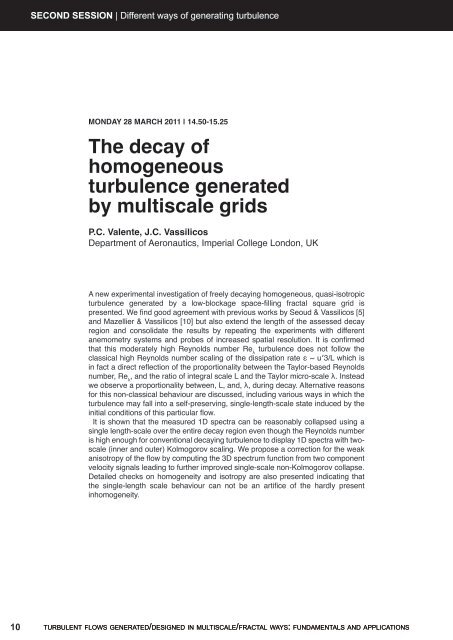Turbulent flows generated/designed in multiscale/fractal ... - Ercoftac
Turbulent flows generated/designed in multiscale/fractal ... - Ercoftac
Turbulent flows generated/designed in multiscale/fractal ... - Ercoftac
You also want an ePaper? Increase the reach of your titles
YUMPU automatically turns print PDFs into web optimized ePapers that Google loves.
SECOND session | Different ways of generat<strong>in</strong>g turbulence<br />
Different ways of generat<strong>in</strong>g turbulence | SECOND session<br />
monday 28 MARCH 2011 | 14.50-15.25 MONDAY 28 MARCH 2011 | 15.25-16.00<br />
The decay of<br />
homogeneous<br />
turbulence <strong>generated</strong><br />
by <strong>multiscale</strong> grids<br />
Fractal <strong>generated</strong><br />
turbulence <strong>in</strong><br />
isothermal and react<strong>in</strong>g<br />
opposed jet <strong>flows</strong><br />
P.C. Valente, J.C. Vassilicos<br />
Department of Aeronautics, Imperial College London, UK<br />
R.P. L<strong>in</strong>dstedt, P. Geipel and K.H.H. Goh<br />
Department of Mechanical Eng<strong>in</strong>eer<strong>in</strong>g, Imperial College London, UK<br />
A new experimental <strong>in</strong>vestigation of freely decay<strong>in</strong>g homogeneous, quasi-isotropic<br />
turbulence <strong>generated</strong> by a low-blockage space-fill<strong>in</strong>g <strong>fractal</strong> square grid is<br />
presented. We f<strong>in</strong>d good agreement with previous works by Seoud & Vassilicos [5]<br />
and Mazellier & Vassilicos [10] but also extend the length of the assessed decay<br />
region and consolidate the results by repeat<strong>in</strong>g the experiments with different<br />
anemometry systems and probes of <strong>in</strong>creased spatial resolution. It is confirmed<br />
that this moderately high Reynolds number Re λ<br />
turbulence does not follow the<br />
classical high Reynolds number scal<strong>in</strong>g of the dissipation rate ε ~ u′3/L which is<br />
<strong>in</strong> fact a direct reflection of the proportionality between the Taylor-based Reynolds<br />
number, Re λ<br />
, and the ratio of <strong>in</strong>tegral scale L and the Taylor micro-scale λ. Instead<br />
we observe a proportionality between, L, and, λ, dur<strong>in</strong>g decay. Alternative reasons<br />
for this non-classical behaviour are discussed, <strong>in</strong>clud<strong>in</strong>g various ways <strong>in</strong> which the<br />
turbulence may fall <strong>in</strong>to a self-preserv<strong>in</strong>g, s<strong>in</strong>gle-length-scale state <strong>in</strong>duced by the<br />
<strong>in</strong>itial conditions of this particular flow.<br />
It is shown that the measured 1D spectra can be reasonably collapsed us<strong>in</strong>g a<br />
s<strong>in</strong>gle length-scale over the entire decay region even though the Reynolds number<br />
is high enough for conventional decay<strong>in</strong>g turbulence to display 1D spectra with twoscale<br />
(<strong>in</strong>ner and outer) Kolmogorov scal<strong>in</strong>g. We propose a correction for the weak<br />
anisotropy of the flow by comput<strong>in</strong>g the 3D spectrum function from two component<br />
velocity signals lead<strong>in</strong>g to further improved s<strong>in</strong>gle-scale non-Kolmogorov collapse.<br />
Detailed checks on homogeneity and isotropy are also presented <strong>in</strong>dicat<strong>in</strong>g that<br />
the s<strong>in</strong>gle-length scale behaviour can not be an artifice of the hardly present<br />
<strong>in</strong>homogeneity.<br />
The opposed jet configuration presents a canonical geometry suitable for the<br />
evaluation of calculation methods seek<strong>in</strong>g to reproduce the impact of stra<strong>in</strong> and<br />
re-distribution on turbulent transport <strong>in</strong> react<strong>in</strong>g and non-react<strong>in</strong>g <strong>flows</strong>. The<br />
geometry has the advantage of good optical access and, <strong>in</strong> pr<strong>in</strong>ciple, an absence<br />
of complex boundary conditions. Disadvantages <strong>in</strong>clude low frequency flow motion<br />
at high nozzle separations and comparatively low turbulence levels caus<strong>in</strong>g bulk<br />
stra<strong>in</strong> to exceed the turbulent contribution at small nozzle separations. In the<br />
current work, <strong>fractal</strong> <strong>generated</strong> turbulence has been used to <strong>in</strong>crease the turbulent<br />
stra<strong>in</strong> and velocity measurements for isothermal and react<strong>in</strong>g <strong>flows</strong> are reported<br />
with an emphasis on the axis, stagnation plane and the distribution of mean and<br />
<strong>in</strong>stantaneous stra<strong>in</strong> rates. Energy spectra were also determ<strong>in</strong>ed and it showed<br />
that <strong>fractal</strong> grids <strong>in</strong>crease the turbulent Reynolds number range from 48–125 to<br />
109–220 for bulk velocities from 4 to 8 m/s as compared to conventional perforated<br />
plate turbulence generators. The applied <strong>in</strong>strumentation comprised hotwire<br />
anemometry, particle image velocimetry and a multi-step adaptive algorithm was<br />
developed and used to determ<strong>in</strong>e conditional statistics for react<strong>in</strong>g cases. Examples<br />
are given with respect to velocity and scalar statistics, the motion of the stagnation<br />
plane and with probability density functions for the <strong>in</strong>stantaneous <strong>in</strong>cl<strong>in</strong>ation of the<br />
flame sheet also determ<strong>in</strong>ed. F<strong>in</strong>ally, a proper orthogonal decomposition technique<br />
was adopted <strong>in</strong> order to exam<strong>in</strong>e the eigenmodes result<strong>in</strong>g from an analysis of the<br />
<strong>in</strong>stantaneous vector fields and the dom<strong>in</strong>ant structures identified. The work shows<br />
that the application of <strong>fractal</strong>-<strong>generated</strong> turbulence holds significant advantages <strong>in</strong><br />
the context of the opposed jet geometry.<br />
10 turbulent <strong>flows</strong> <strong>generated</strong>/<strong>designed</strong> <strong>in</strong> <strong>multiscale</strong>/<strong>fractal</strong> ways: fundamentals and applications<br />
turbulent <strong>flows</strong> <strong>generated</strong>/<strong>designed</strong> <strong>in</strong> <strong>multiscale</strong>/<strong>fractal</strong> ways: fundamentals and applications 11

















